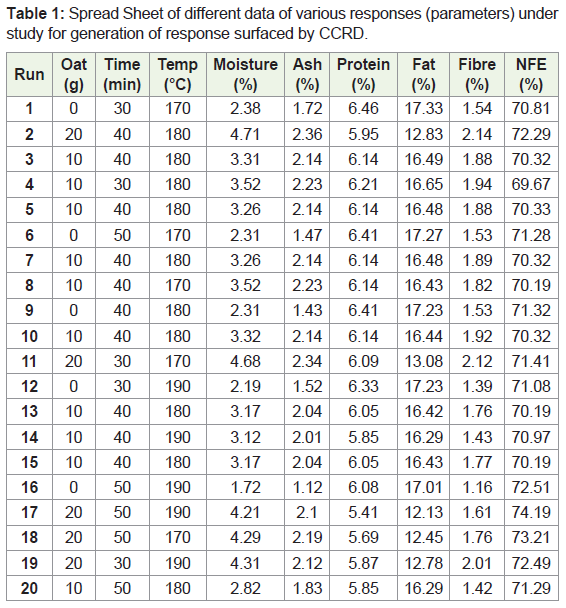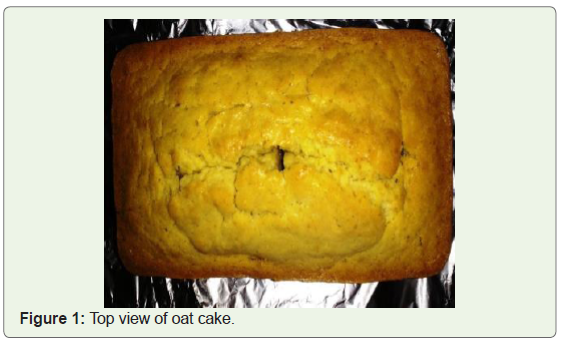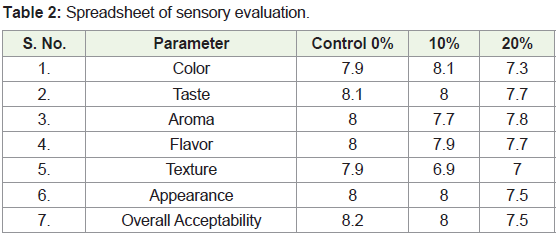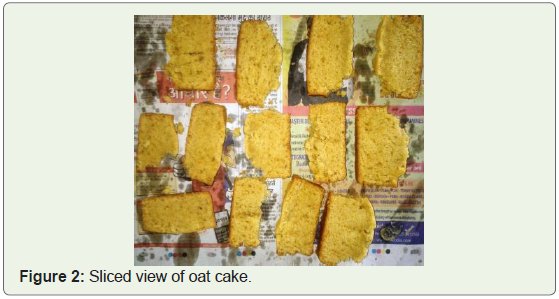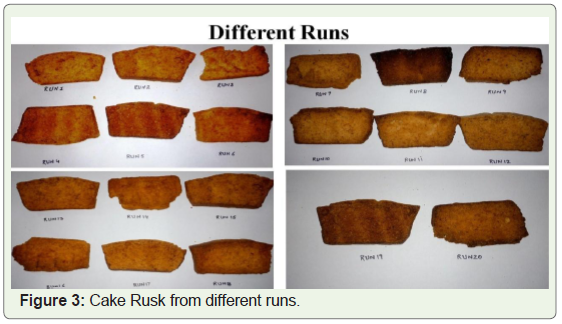Research Article
Development and Quality Evaluation of Oat-Fortified Cake Rusk
Bajpai V, Shukla P* and Shukla RN
Department of Food Technology, Sam Higginbottom University of Agriculture, India
Corresponding author: Priyanka Shukla, Department of Food Technology, Sam Higginbottom University of Agriculture, Technology & Sciences, India, Tel: 9729535300; E-mail: priyankashukla27dec@gmail.com
Citation: Bajpai V, Shukla P, Shukla RN. Development and Quality Evaluation of Oat-Fortified Cake Rusk. Indian J Nutri. 2018;5(1): 179.
Copyright © 2018 Bajpai V, et al. This is an open access article distributed under the Creative Commons Attribution License, which permits unrestricted use, distribution, and reproduction in any medium, provided the original work is properly cited.
Indian Journal of Nutrition | ISSN: 2395-2326 | Volume: 5, Issue: 1
Submission: 22/11/2017; Accepted: 05/01/2018; Published: 10/01/2018
Abstract
The study was done on optimization of oat cake rusk formulation using Response Surface Methodology (RSM). Different formulation level such as Oat Concentration, Time and Temperature were optimized using face centered central composite design in software Design Expert 9. The oat percentage was varied from 0 to 20, temperature from 170 °C to 190 °C and time from 30 min to 50 min. The incorporation of oat makes cake rusk rich in fiber content 2.14g/100g. Cake rusk of good technological quality and with a good level of acceptance was obtained in containing 10% oat flour baked at 180 °C for 30 min. The nutritional content like Protein 6.21g/100g was found to be increased from controlled sample, ash content 2.23g/100g due to high mineral content in oats found to be increased, fat 16.65g/100g due to more fat affinity in oats got increased and nitrogen free extract 69.7g/100g ultimately affected due to increase in other above factors.
Keywords:
Response surface methodology; Oat; Time; Temperature; Baked
Introduction
The bakery industry in India is the largest organized food industry, with an annual turnover of Rs. 800 crores. The industry mainly consists of bread, biscuits and cake manufacturing units. The production of bakery products has doubled over the last 10 years from 1.8 MT to about 3.5 MT.
One of today’s major nutritional problems is the consumption of high amounts of fat and low amounts of fiber associated with increased incidence of obesity, coronary heart diseases, hypertension, insulin resistance, gall bladder disease and certain cancers-e.g. breast, colon and prostate. As a result, in spite of the important role played by fat, there have been continued efforts to reduce the fat content in food products and to replace them with various fat replacers. Thus, the demand for low fat/calorie foods and those enriched with dietary fiber in the market has been increasing over the years.
Oats (Avena sativa) grains are relatively rich in oil compared with other cereals and can vary from 3% to 11% of grain weight in different cultivars, with lines containing up to 18%. Unlike other cereals, the major portion of the oil in oat grains has been claimed to be in the endosperm. Most oat cultivars have about 5-6% of oil and 55-60% of starch in the grain. Oats provide one of the richest sources of the dietary soluble fiber beta-glucan providing 5.0 g (oatmeal) to 7.2 g (oat bran) per 100 g serving. Oats also contain more lipids (5-9%) than other cereal crops and are rich in unsaturated fats, including the essential fatty acid linoleic acid [1]. Oats contain unique antioxidants, called avenanthramides, as well as the vitamin E-like compounds, tocotrienols and tocopherols.
The hypocholesterolemic effects of oats are well documented in over 50 clinical studies. However, oats also exert cardiovascular benefits that go beyond its cholesterol-reducing properties. Fibre enrichment and fat replacement are effective ways in developing a health-promoting diet. β-glucan, a soluble dietary fibre present in cereal grains, has many health benefits, which include reduction in blood cholesterol and, improving insulin response. Due to its viscosity enhancing and water binding properties β-glucan is considered as a potential fat replacer. β-glucan enrichment of foods or its addition as a fat replacer brings enormous health benefits to the consumers. β-glucan is a polymer of glucose and can be sourced from cereal grains (barely, oat), mushrooms and yeasts. Oat and barley β-glucan, soluble dietary fiber, have the ability to control post-prandial blood glucose and insulin levels and to lower blood cholesterol levels [2]. β-glucan is involved in reducing risks of major diseases, such as obesity, coronary diseases, gastrointestinal disorders and colon cancers.
Whole grains are associated with a lower risk of the following conditions: 1) Heart disease and stroke, research shows a 20-40% reduction in heart disease risk for people eating the most wholegrain. 2) Weight control, wholegrain foods not only provide volume, but are also high in fiber and complex carbohydrates, making you feel full longer and less likely to snack. 3) Type 2 diabetes, people consuming the most whole grains have been found to have a 20 - 30% reduction in risk of diabetes. 4) Bowel health and regularity, the fiber found in whole grains helps improve digestive health. 5) Cholesterol and blood pressure, whole grains containing soluble fiber, such as barley, have the capacity to help reduce LDL cholesterol levels. The increased intake of whole grains has also been linked to lower blood pressure. 6) Cancer, regularly consuming whole grains may reduce the risk of developing colon cancer by 30-40%.
RSM is an important subject in the statistical design of experiments. It is a collection of mathematical and statistical techniques useful for the modeling and analysis of problems in which a response of interest is influenced by several variables and the objective is to optimize this response [3].
Cake products are enjoyed by many, but they are less nutritious and have a limited shelf life and not always convenient to carry to school or work. These hurdles can be greatly circumvented by formulating a product which uses nutritious ingredients at the minimal level consistent with product quality, and is processed further to allow both an improvement in shelf-life and the convenience of packaging and use.
Multi grain Cake Rusk include with wheat and oats. Thesesingredient gives all nutritional values and provide us with healthy snack food. These are easily available in local market. The work deals with the Manufacturing of Multi grain cereal based cake rusk. With the advent of latest food technology and quality analysis via physical, chemical and sensory evaluation, it has become possible for targeting major population with healthy nutritious food requirement.
In a recent survey, almost 37% of Indian adults were identified as overweight or obese. Food intake and possibly overconsumption may be influenced by people’s perception of food’s healthiness and fat content. Nowadays demand of high fiber food had increased as the food habits of people had changed. So cake rusk snacks will provide high fiber and energy. These can be taken by people of any age group. It also helps in lowering the cholesterol level of the body. The study was conducted with following objectives:
1. To develop the multi grain cake rusk,
2. To optimize the blend ratio of wheat-oats, time and temperature using response surface methodology,
3. To study the physicochemical and sensory characteristics of developed cake rusk.
Materials and Methods
This chapter deals with the description of various materials and methods used to accomplish the experimental work done to attain the desired objectives of the study entitled, “Development & Quality Evaluation of Oat-Fortified Cake Rusk”. The methodology adopted has been described under the following headings.
Materials
The formulation table for the preparation of cake rusk is shown in [4] (Table 1).
Methods
The method of preparation of cake rusk is shown in the Figure 1 as well the process flow chart for preparation of cake rusk is depicted in (Figure 1).
Physicochemical characteristics
Determination of moisture content: The moisture content in the sample was estimated according to the method of AOAC (1990) [5].
Ash content: The ash content in the sample was estimated according to AOAC (1990) [5].
Determination of fat content: The fat content of the sample was determined by the procedure as described in AOAC (1990) [5].
Determination of crude fibre: The crude fibre was determined by the method as described in AOAC (1990) [5].
Proteins: The proteins were determined by the Micro-Kjeldahl method.
Sensory evaluation
The Sensory characteristics of the product such as general appearance, color, taste, and flavor were evaluated by panel of judges using nine point hedonic scale as per IS: 6273 (PART – II), 1971. The acceptability statements and their marks used are shown in Table 2.
Statistical Analysis
The experiment was conducted by adopting completely randomized design the data recorded during the course of investigation were statistically analyzed by the ‘Analysis of variance- Two way classification or single factor’ anova. This technique was developed by Fisher in 1923 gives an appropriate method capable of analyzing the variation of population variance. The significant affect of treatment was judged with the help of ‘F’ (variance ratio). Calculated F value was compared with the table value of F at 5% level of significance. If calculated value exceeded the table value the affect was considered to the significant. The significance of the study was tested 5% level.
Results and Discussion
This chapter presents the results of analysis of “Development & Quality Evaluation of Multi Grain Cake Rusk” [6]. The present investigation was undertaken to evaluate the quality as well as acceptability of oats cake rusk. The chemical, physical analysis and organoleptic evaluation of oats cake rusk has been carried out.
Development of cake rusk
The cake as shown in Figure 1 and 2 was first prepared and then re baked to develop cake rusk was shown in Figure 3.
Optimization of cake rusk using RSM
In the present study, Central Composite Rotatable Design (CCRD) for five variables at five levels ( -2, -1, 0, 1, 2) was used and observations were recorded accordingly and based on the observations recorded the response surfaces were generated by using 45 days trial pack of statistical analysis software name Design expert 9.0.5 [7].
The dependent variable for which the response surfaces were generated was categorized as per their status. The physicochemical parameters included: moisture, protein, fat, fiber, NFE and ash content of cake rusk as mentioned in Table 1.
The observations recorded are listed in design expert spread sheet, their analysis followed by discussions and interpretation is presented in this chapter. The results are further encompassed with second order polynomial models and whose adequacy was also tested by following standard statistical process. Three dimensional graphs were also developed to illustrate the variation of the parameters with respect to different levels of parameters.
Physicochemical parameter
Moisture: The studies showed that the moisture content increases with increase in oat proportion, as oat can hold more moisture than wheat flour but moisture content of the product decreases with the increase in baking time and baking temperature.
Ash content: The protein content decreased with increase in oat proportion, as oat contains more fibre content overall and less protein in comparison. In increasing baking time and baking temperature, protein content decreases.
Fat: In case of the fat content decreases with increase in oat proportion, as oat has less fat content than wheat flour. With the increase in baking time and baking temperature of cake rusk, fat content decreased.
Fibre: The fibre content increased with increase in oat proportion, as oat contains much higher fibre content than wheat flour. As the time and temperature increases, fibre content of the cake rusk decreased.
Nitrogen free extract: The nitrogen free extract increases with increase in oat proportion, as oat contains high amount of carbohydrate. And also with increasing temperature and time, other content decreases and ultimately nitrogen free extract increased.
As per the sensory evaluation, which was carried out with 10 members, cake rusk with 0% oats has been liked very much, with added fortification of oat as 10% and 20%, 10% was more liked than 20% shown in Table 2.
Summary
Cake products are enjoyed by many in India and are preferred and loved by almost every individual irrespective of class and age, but they are less nutritious and have a limited shelf life and not always convenient to carry to school or work. These problems eliminated by formulating a product which uses nutritious ingredients at the minimal level consistent with product quality, and is processed further to allow both an improvement in shelf-life and the convenience of packaging and use [8].
The present research indicates that these oats are very rich in fiber content. Oats protect against incidence of obesity, coronary heart diseases, hypertension, insulin resistance, gall bladder disease and certain cancers-e.g. breast, colon and prostate. As oats are rich in fiber content, they were incorporated in the wheat flour to increase the fiber content of the cake rusk. The various factors such as oat proportion, time and temperature were optimized using Response Surface Methodology (RSM) by Design Expert 9.0.5. The oat flour was added with wheat flour in the range of 0 to 20 percent temperature varied from 170 °C to 190 °C and time from 30 min to 50 min in different samples respectively.
When the chemical analysis was done there was significant increase in the moisture content, ash content and fiber content as the incorporation of oat flour increases from 0 % to 20% baked at 180 °C for 40 min. But changes were observed when time and temperature were changed as responses get denatured at higher temperature and time, at lower temperature and time they are not properly formed.
Conclusion
The utilization of oat along with wheat flour increased the nutritional value of cake rusk. The analytical work signified the increase in the amount of protein, fiber, fat and ash content. From all the trials it was seen that the oat cake rusk with 10% oat flour has fiber content 2.14g/100g which was found to be increased from controlled sample, protein 6.21g/100g, ash content 2.23g/100g due to high mineral content in oats found to be increased, fat 16.65g/100g and nitrogen free extract 69.7g/100g ultimately affected due to increase in other above factors. The oat cake rusk with 10% oat flour was accepted by panel judges depending on sensory evaluation and from all the trials it was seen that the oat cake rusk with 20% oat flour was best according to nutritional value.
References
- Katz D (2001) A scientific review of the health benefits of oats. The Quaker Oats Company pp. 1-11.
- Brown L, Rosner B, Willett W, Sacks F (1999) Cholesterol-lowering effects of dietary fiber: a meta-analysis 69: 30-42.
- Montgomery D (2005) Design and analysis of experiments, Hoboken NJ, Wiley (Eds 6th).
- Masih A, Raj A, Rubila S, Patil R, Ranaganathan T (2013) Preparation of laminated baked product using oats. J Food Process and Technol 4: 3.
- AOAC (1990) Association of analytical chemist; Officials of analysis (Eds 15th) Washington DC.
- Zohng H (2013) Effect of lipid source on the physical and sensory quality of baked products. Utah State University Digital Commons.
- Song Y, Du B, Zhou T, Han B, Yu F, et al. (2011) Optimization of extraction process by response surface methodology and preliminary structural analysis of polysaccharides from defatted peanut cakes. Carbohydr Res 346: 305-310.
- Yaseen A (2000) Formulating a new high fiber rusk for production on commercial scale. Nahrung 44: 110-113.

